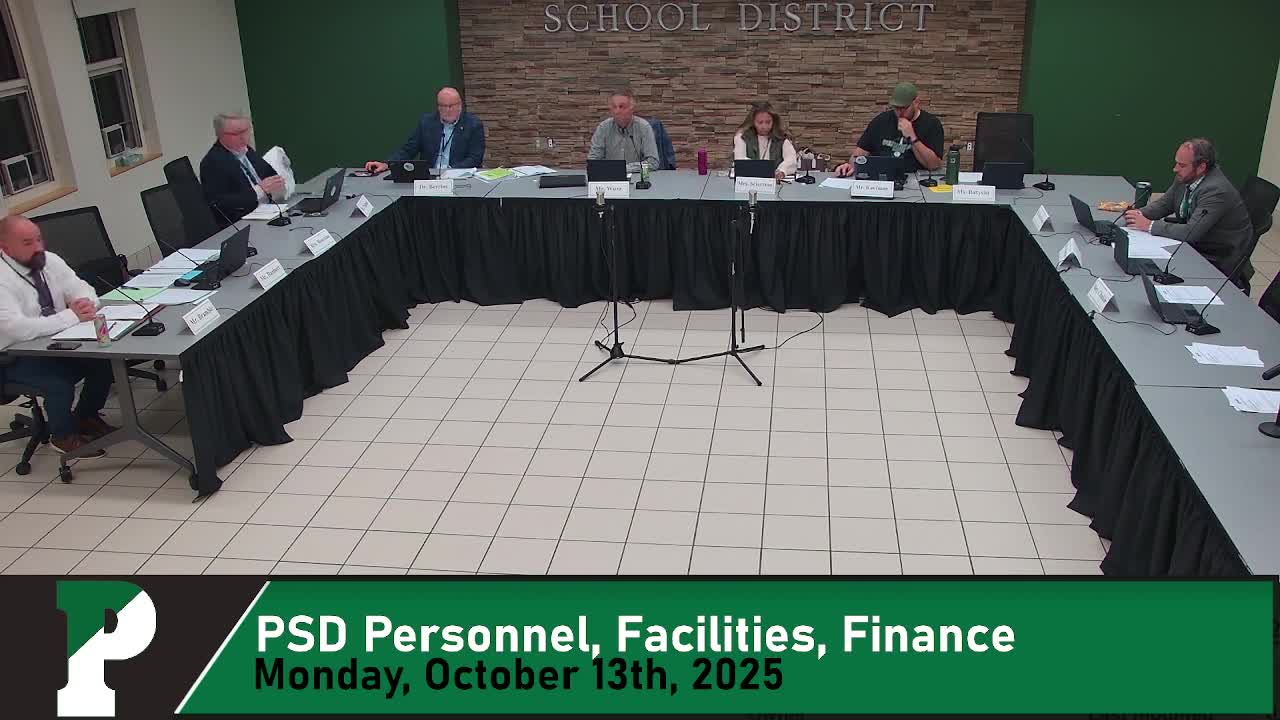Pennridge finance committee reviews Act 1 index, shortfalls and budget pressures for 2026-27
October 13, 2025 | Pennridge SD, School Districts, Pennsylvania
This article was created by AI summarizing key points discussed. AI makes mistakes, so for full details and context, please refer to the video of the full meeting. Please report any errors so we can fix them. Report an error »

Finance staff briefed the committee Oct. 13 on the Act 1 index for the 2026-27 budget and related revenue pressures. The Pennsylvania Act 1 index for 2026-27 was certified at 3.5 percent; using the district’s current tax base and a 140 mills starting point, staff said that a 3.5 percent Act 1 increase would be equivalent to raising the rate to about 145 mills and would generate roughly $3,210,000 under current assessed values.
Sean (finance presenter) and other staff outlined three converging revenue pressures: slowed assessed-value growth, declining or variable earned-income-tax (EIT) receipts and uncertainty in state education funding. Staff reported the district’s current assessed value at roughly $672,916,760; assessed-value growth that once produced larger local revenue gains has trended down to fractional-percentage increases in recent years. EIT receipts, which rose sharply during and immediately after the pandemic, fell short of 2024-25 budget expectations and show lower year-over-year growth in 2024-25 compared with 2021–2023 levels.
On state funding, staff said the governor’s 2025-26 budget proposal had included modest increases to basic education, special education, ready-to-learn and a new adequacy line item; however, a recent House bill (SB 160) proposed numbers that were about $82,500 lower for Pennridge than the governor’s proposal. Staff warned the senate had not yet acted and indicated the final state budget could come in worse than the House bill. The finance presenter also said that, through October, cumulative lost or delayed state funding compared with the prior year totaled roughly $9,844,000 for the district (staff provided ongoing updates to the board on the magnitude of delayed or withheld state payments during the budget impasse).
On the expenditure side, staff noted salary and benefits costs are the district’s largest recurring obligations. Finance staff showed recent contract and salary settlements with PEA and PESPA and projected the district could face roughly $1.8 million in salary pressure for 2026-27 from those agreements alone, in addition to expected healthcare cost increases and potential restoration of items trimmed from prior budgets (for example, bus service allocations). Committee members discussed the option of adopting the Act 1 “opt-out” resolution (which permits the district to plan and adopt a budget under the Act 1 index rather than seeking referendum exceptions) and staff noted the district has typically adopt an opt-out resolution in October to preserve the full budget-development timetable that runs from November through a final June adoption.
Committee members asked for more modeling and stressed the need to pursue cost reductions and staffing right-sizing measures while continuing to advocate with state officials for timely funding. Finance staff said they would return with more granular options as the district moves through the 2026-27 budget cycle.
Sean (finance presenter) and other staff outlined three converging revenue pressures: slowed assessed-value growth, declining or variable earned-income-tax (EIT) receipts and uncertainty in state education funding. Staff reported the district’s current assessed value at roughly $672,916,760; assessed-value growth that once produced larger local revenue gains has trended down to fractional-percentage increases in recent years. EIT receipts, which rose sharply during and immediately after the pandemic, fell short of 2024-25 budget expectations and show lower year-over-year growth in 2024-25 compared with 2021–2023 levels.
On state funding, staff said the governor’s 2025-26 budget proposal had included modest increases to basic education, special education, ready-to-learn and a new adequacy line item; however, a recent House bill (SB 160) proposed numbers that were about $82,500 lower for Pennridge than the governor’s proposal. Staff warned the senate had not yet acted and indicated the final state budget could come in worse than the House bill. The finance presenter also said that, through October, cumulative lost or delayed state funding compared with the prior year totaled roughly $9,844,000 for the district (staff provided ongoing updates to the board on the magnitude of delayed or withheld state payments during the budget impasse).
On the expenditure side, staff noted salary and benefits costs are the district’s largest recurring obligations. Finance staff showed recent contract and salary settlements with PEA and PESPA and projected the district could face roughly $1.8 million in salary pressure for 2026-27 from those agreements alone, in addition to expected healthcare cost increases and potential restoration of items trimmed from prior budgets (for example, bus service allocations). Committee members discussed the option of adopting the Act 1 “opt-out” resolution (which permits the district to plan and adopt a budget under the Act 1 index rather than seeking referendum exceptions) and staff noted the district has typically adopt an opt-out resolution in October to preserve the full budget-development timetable that runs from November through a final June adoption.
Committee members asked for more modeling and stressed the need to pursue cost reductions and staffing right-sizing measures while continuing to advocate with state officials for timely funding. Finance staff said they would return with more granular options as the district moves through the 2026-27 budget cycle.
View full meeting
This article is based on a recent meeting—watch the full video and explore the complete transcript for deeper insights into the discussion.
View full meeting